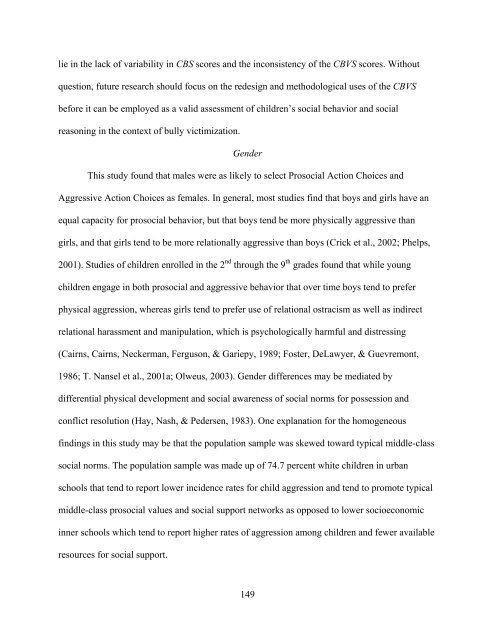Copyright Malvin Porter, Jr. 2010 - acumen - The University of ...
Copyright Malvin Porter, Jr. 2010 - acumen - The University of ...
Copyright Malvin Porter, Jr. 2010 - acumen - The University of ...
You also want an ePaper? Increase the reach of your titles
YUMPU automatically turns print PDFs into web optimized ePapers that Google loves.
lie in the lack <strong>of</strong> variability in CBS scores and the inconsistency <strong>of</strong> the CBVS scores. Without<br />
question, future research should focus on the redesign and methodological uses <strong>of</strong> the CBVS<br />
before it can be employed as a valid assessment <strong>of</strong> children’s social behavior and social<br />
reasoning in the context <strong>of</strong> bully victimization.<br />
Gender<br />
This study found that males were as likely to select Prosocial Action Choices and<br />
Aggressive Action Choices as females. In general, most studies find that boys and girls have an<br />
equal capacity for prosocial behavior, but that boys tend be more physically aggressive than<br />
girls, and that girls tend to be more relationally aggressive than boys (Crick et al., 2002; Phelps,<br />
2001). Studies <strong>of</strong> children enrolled in the 2 nd through the 9 th grades found that while young<br />
children engage in both prosocial and aggressive behavior that over time boys tend to prefer<br />
physical aggression, whereas girls tend to prefer use <strong>of</strong> relational ostracism as well as indirect<br />
relational harassment and manipulation, which is psychologically harmful and distressing<br />
(Cairns, Cairns, Neckerman, Ferguson, & Gariepy, 1989; Foster, DeLawyer, & Guevremont,<br />
1986; T. Nansel et al., 2001a; Olweus, 2003). Gender differences may be mediated by<br />
differential physical development and social awareness <strong>of</strong> social norms for possession and<br />
conflict resolution (Hay, Nash, & Pedersen, 1983). One explanation for the homogeneous<br />
findings in this study may be that the population sample was skewed toward typical middle-class<br />
social norms. <strong>The</strong> population sample was made up <strong>of</strong> 74.7 percent white children in urban<br />
schools that tend to report lower incidence rates for child aggression and tend to promote typical<br />
middle-class prosocial values and social support networks as opposed to lower socioeconomic<br />
inner schools which tend to report higher rates <strong>of</strong> aggression among children and fewer available<br />
resources for social support.<br />
149

















